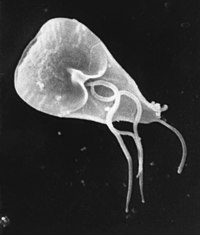
Photo from wikipedia
Dientamoeba fragilis is a flagellated protozoan with amoeba‐like morphology that inhabits the human gastrointestinal tract. It is endemic in a vast geography around the world, including developed countries. There are… Click to show full abstract
Dientamoeba fragilis is a flagellated protozoan with amoeba‐like morphology that inhabits the human gastrointestinal tract. It is endemic in a vast geography around the world, including developed countries. There are limited studies on non‐human hosts of the parasite, and suitable hosts have not been clarified. The parasite has been detected in non‐human primates, pigs, cats, dogs and rats. There is no study in the literature investigating and detecting the presence of this parasite in cattle. In this study, stool samples taken from 163 different cattle and calves from 11 different farms between March 2017 and May 2022 were examined for the detection of D. fragilis via PCR. Trichrome staining was performed on all PCR‐positive samples. The isolates with the expected amplicon size were sequenced using the 18S ribosomal RNA region, and their genotypes were determined by BLAST analysis. Sequences were analysed with the most similar and reference sequences in the literature, forming a phylogenetic tree. We detected D. fragilis in 31 (19.01%) of the 163 stool samples. D. fragilis cysts/trophozoites were detected by trichrome staining method in six of 31 samples. All PCR products selected for molecular analysis from positive samples had the same nucleotide sequence. As a result of BLAST analysis, all sequences were determined to belong to D. fragilis genotype 1. This study determined for the first time that cattle are suitable hosts for D. fragilis. Furthermore, the parasite subtype we detected belongs to genotype 1, which is the most common type in humans, suggesting that the parasite may have a zoonotic character. Our result is important in terms of the epidemiology of the parasite, as the mode of transmission is controversial, and available data on its suitable hosts are limited.
Journal Title: Zoonoses and Public Health
Year Published: 2022
Link to full text (if available)
Share on Social Media: Sign Up to like & get
recommendations!